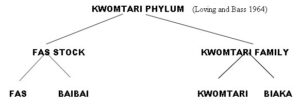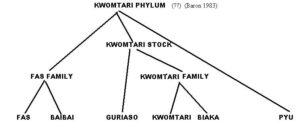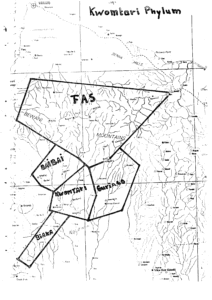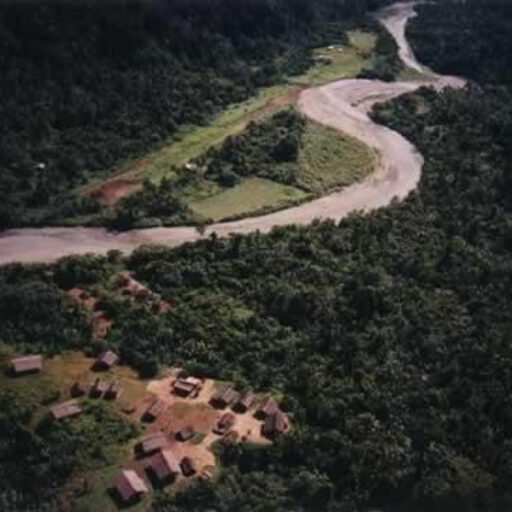Kwomtari Survey
The Kwomtari Phylum
(This Site is still under Construction)
Wietze Baron
Started: October 2007
Language classifications
As in biology with its classification of species, linguists also have a need for classification. They used to use terms like Phylum, Stock, Family and Dialects to classify the languages of the world. The phyla were the broadest groups. These were in turn subdivided in terms of stocks, stocks in terms of families etc. But as the relationships turned out to be too complex for such a simple taxonomy, the tendency is now to respresent them in terms of tree structures. A broad, largely geographically determined, division is made in terms of PHYLA, and from there on all we find is Language Trees.
Cf. Global Mapping International and The Ethnologue, languages of the world
We lived as a family in the Fas (Momu)-speaking village of Kilifas, Sandaun Province, Papua New Guinea. Papuan languages have traditionally been considered impossible to place within external phyla. Even within Papua New Guinea itself, languages were so diverse that a number of special phyla were laid out. The Fas-language had been placed in the Kwomtari Phylum by Loving and Bass.
They suggested the following language tree:

Kwomtari and Biaka are clearly fairly closely related languages, but Fas and Baibai are even closer. It therefore made no sense that they were grouped at a Stock level. I was able to consult their survey data and it turned out that in their typed data sheets, a large part of the corpus had been skewed, probably by a typing error where the glosses appeared a line lower than the items they belonged to. This may also have put Don Laycock off the track, when in 1975 he suggested the following classification
Laycock added PYU on the border with Irian Jaya.

My family lived in the Fas speaking village of Kilifas, intermittently from 1977 – 1988. In 1983 I was able to carry out a helicopter supported survey of key locations within this phylum. A short wordlist of 100 items was used, but I also looked at aspects of syntax and morphology. As a result I suggested the following language tree:

The survey revealed the existence of a hitherto unkown language which I have called GURIASO, following the name of a central village. I frankly have no idea of what the phylum and stock characteristics would be in this representation. In that respect I am simply following the Loving and Bass and Laycock precedent. A copy of the report was sent to the Linguistics Department of SIL Ukarumpa, the Linguistics Department of the University of Papua New Guinea and to the Australian National University (care of Stephen Wurm and Don Laycock). Don Laycock responded a year or so later expressing strong feelings that PYU was part of this taxonomy. The rough draft is now available: Kwomtari Survey A summary is contained in my paper called Malay Influence on West Sepik Kinship Terminology., read at a meeting of the Linguistic Society of Papua New Guinea.
A Geographic Outline of the Kwomtari Phylum Territory
(to be replaced)

![]()
Village index
This index lists the villages belonging to each language and the population figures from the 1979 census. As you can tell from names like Tamina 1, Tamina 2 etc., the names were often thought up by patrol officers. People traditionally live in small clan hamlets. Government authorities put pressure on them to go and live in larger villages.
| FAS | Resident | Absent | Total |
| Yo | 82 | 13 | 95 |
| Sumumini | 119 | 4 | 123 |
| Wara Mayu | 57 | 20 | 77 |
| Kilifas | 120 | 17 | 137 |
| Fugumui | 114 | 10 | 124 |
| Fas 2 | 117 | 17 | 134 |
| Fas 3 | 77 | 13 | 90 |
| Finamui | 30 | 8 | 38 |
| Fugeri | 128 | 8 | 136 |
| Aiamina | 68 | 5 | 73 |
| Tamina 1 | 73 | 9 | 82 |
| Nebike | 132 | 4 | 136 |
| Tamina 2 | 40 | 17 | 57 |
| Utai | 81 | 3 | 84 |
| Mumuru | 99 | 7 | 106 |
| Savamui | 32 | 18 | 50 |
| Mori | 78 | 9 | 87 |
| Total | 1447 | 182 | 1629 |
| BAIBAI | Resident | Absent | Total |
| Itomi | 65 | 15 | 80 |
| Piemi | 47 | 10 | 57 |
| Baibai | 60 | 16 | 76 |
| Yebdibi | 70 | 1 | 71 |
| Total | 242 | 42 | 284 |
| KWOMTARI | Resident | Absent | Total |
| Mango | 64 | 1 | 65 |
| Kwomtari | 86 | 12 | 98 |
| Baiberi | 79 | 23 | 102 |
| Yenabi | 109 | 41 | 150 |
| Yau’uri | 84 | 20 | 415 |
| Wagroni | 39 | ? | >39 |
| Total | 461 | >97 | >558 |
| BIAKA | Resident | Absent | Total |
| Konabasi | 146 | 6 | 152 |
| Biaka | 200 | 9 | 209 |
| Amini | 100 | ? | >100 |
| Total | 446 | >15 | >461 |
| Grand total | 2596 | >336 | >2932 |
